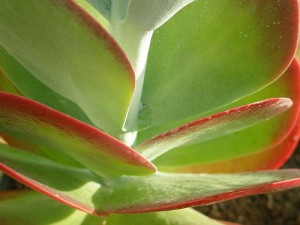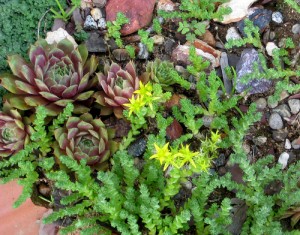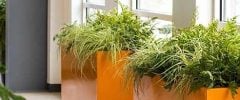Top Tips for Creating Succulent Arrangements
Succulents make a perfect tabletop arrangement for several reasons. They can be low growing and thrive in shallow containers. Therefore, you can set them on a table, but they will not obstruct your line of vision. They are also very easy to care for and can survive the low relative humidity that is so common in the winter. Here are a few tips for creating and managing attractive, yet subtle arrangements.
Subtle Beauty
The idea behind these arrangements is to create a quiet feel of natural ambience not the spectacular flair so often desired in indoor plantscapes. Choose plants that are low growing yet have interesting variation in color or shape. While all the plants should be relatively short you still want to use some contrast in height. Pick one or two plants that are a few inches tall and then use very short mounding or trailing succulents around the perimeter.
Succulent Varieties
The paddle plant is an excellent anchor plant. Its round, flat, paddle shaped leaves grow  up to six inches tall. When exposed to bright light the foliage will develop a reddish tinge around the margins.
up to six inches tall. When exposed to bright light the foliage will develop a reddish tinge around the margins.
Echeveria is a genus of succulent that grows in small rosettes. They often produce offsets referred to as “chicks.” This characteristic makes them one of several different species referred to as “Hens and Chicks.” According to Guide to Houseplants, there are many different varieties of Echeveria. Most grow between 2 and 4 inches tall. Many have foliage that is a beautiful blue-green color. Echeveria is perfect for adding interesting shape and form to a succulent arrangement. Sempervivum is another genus that is often referred to as “Hens and Chicks.” Better Homes and Gardens suggests two interesting varieties of Sempervivum, Bronco Hens and Chicks and Cobweb Buttons Hens and Chicks. Hens  and Chicks are great accent plants, but they can also stand alone in a container.
and Chicks are great accent plants, but they can also stand alone in a container.
The Rosary Plant or Crassula rupestris is a unique trailing plant. The plant has tiny leaves shaped so that the plant has a square look. According to The Garden Pages, the Rosary Plant can survive from part shade to full sun. When exposed to more sun the leaves will develop a touch of red color on the tips. Keeping the plant trimmed will prevent it from becoming leggy. Other trailing succulents include String of Pearls Plant and many varieties of Sedum such as Sedum spurium ‘Red Carpet’ or Sedum longipes.
Finding a Container
Once you have selected a variety of succulents choose a shallow container large enough to fit the size and number of plants. The Fiberglass Flowerbowl or Fiberglass Orchid Bowl are both currently on sale at NewPro Containers. Either container would work well for a succulent arrangement. Fill the selected container with a potting mix formulated for succulents. It should be well draining and slightly acidic. Place the plants so that it is level with the top of the container. Placing the plants close together will help the arrangement look full. You can also place the succulents in grow pots directly in the container. Sometimes before placing the plants you will need to add a few inches of potting mix at the bottom of the container to ensure the plants will sit near the top of the container. Fill around the plants with a well draining potting mix and then use a top dressing such as pebbles or faux rocks to hide the plastic rims.
Care
The potting mix should be allowed to dry between each watering. Make sure water does not remain in any leaf axils. Plants that stay wet will encourage rot and pests. The plants can be fertilized during the growing season in the spring and summer months. Bright, indirect light is ideal for most succulents. If your tabletop is not exposed to much light choose varieties that tolerate shade.
It is simple to make easy to care for succulent arrangements that are very attractive without appearing overpowering. Succulents create a peaceful and natural environment without getting in the way or demanding too much attention and making them perfect for a reception desk, windowsill or tabletop. What succulents have you used in a tabletop arrangement? Are there any challenges you have faced while using succulents in indoor plantscapes?
You May Also Like
Leave a Reply
You must be logged in to post a comment.



















